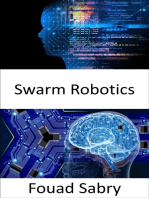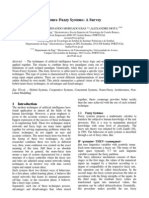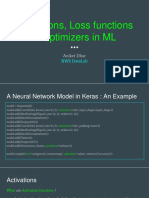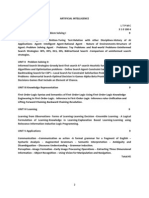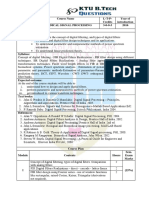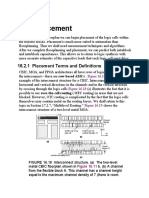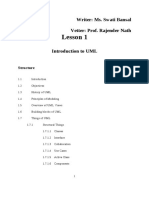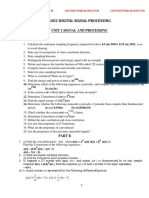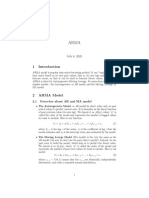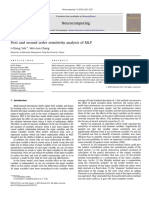Probability Theory and Stochastic Processes
Probability Theory and Stochastic Processes
Uploaded by
smyle_nagCopyright:
Available Formats
Probability Theory and Stochastic Processes
Probability Theory and Stochastic Processes
Uploaded by
smyle_nagOriginal Title
Copyright
Available Formats
Share this document
Did you find this document useful?
Is this content inappropriate?
Copyright:
Available Formats
Probability Theory and Stochastic Processes
Probability Theory and Stochastic Processes
Uploaded by
smyle_nagCopyright:
Available Formats
PROBABILITY THEORY AND STOCHASTIC PROCESSES
III Semester: ECE
Course Code Category Hours / Week Credits Maximum Marks
L T P C CIA SEE Total
AECB08 Core
3 1 0 4 30 70 100
Contact Classes: 45 Tutorial Classes:15 Practical Classes: Nil Total Classes: 60
OBJECTIVES:
The course should enable the students to:
I. Give basic understanding of random signals and processing.
II. Utilization of Random signals and systems in Communications and Signal Processing areas.
III. Known the Spectral and temporal characteristics of Random Process.
IV. Learn the Basic concepts of Noise sources.
MODULE - I PROBABILITY & RANDOM VARIABLES Classes: 08
Probability introduced through Sets and Relative Frequency: Experiments and Sample Spaces, Discrete
and Continuous Sample Spaces, Events, Probability Definitions and Axioms, Joint Probability,
Conditional Probability, Total Probability, Bay’s Theorem, Independent Events.
Random Variables- Definition, Conditions for a Function to be a Random Variable, Discrete, Continuous
and Mixed Random Variable, Distribution and Density functions, Properties, Binomial, Poisson,
Uniform, Gaussian, Exponential, Rayleigh, Methods of defining Conditioning Event, Conditional
Distribution, Conditional Density and their Properties.
MODULE - II OPERATIONS ON SINGLE & MULTIPLE RANDOM VARIABLES Classes: 10
– EXPECTATIONS
Expected Value of a Random Variable, Function of a Random Variable, Moments about the Origin,
Central Moments, Variance and Skew, Chebychev’s Inequality, Characteristic Function, Moment
Generating Function, Transformations of a Random Variable - Monotonic and Non-monotonic
Transformations of Continuous and Discrete Random Variable, Vector Random Variables, Joint
Distribution Function and its Properties, Marginal Distribution Functions, Conditional Distribution and
Density – Point Conditioning, Conditional Distribution and Density – Interval conditioning, Statistical
Independence, Sum of Two and more Random Variables, Central Limit Theorem, Equal and Unequal
Distribution. Expected Value of a Function of Random Variables- Joint Moments about the Origin, Joint
Central Moments, Joint Characteristic Functions, Jointly Gaussian Random Variables: Two Random
Variables case, N Random Variable case, Properties, Transformations of Multiple Random Variables,
Linear Transformations of Gaussian Random Variables.
MODULE - III RANDOM PROCESSES – TEMPORAL CHARACTERISTICS Classes: 10
The Random Process Concept, Classification of Processes, Deterministic and Nondeterministic Processes,
Distribution and Density Functions, concept of Stationarity and Statistical Independence. First- Order
Stationary Processes, Second- Order and Wide-Sense Stationarity, (N-Order) and Strict-Sense
Stationarity, Time Averages and Ergodicity.
Mean-Ergodic Processes, Correlation-Ergodic Processes, Autocorrelation Function and Its Properties,
Cross-Correlation Function and Its Properties, Covariance Functions, Gaussian Random Processes,
Poisson Random Process. Random Signal Response of Linear Systems: System Response – Convolution,
Mean and Mean-squared Value of System Response, autocorrelation Function of Response, Cross-
Correlation Functions of Input and Output.
MODULE - IV RANDOM PROCESSES – SPECTRAL CHARACTERISTICS Classes: 08
The Power Spectrum: Properties, Relationship between Power Spectrum and Autocorrelation Function,
The Cross-Power Density Spectrum, Properties, Relationship between Cross-Power Spectrum and Cross-
Correlation Function. Spectral Characteristics of System Response: Power Density Spectrum of
Response, Cross-Power Density Spectrums of Input and Output.
MODULE - V NOISE SOURCES & INFORMATION THEORY Classes: 09
Resistive/Thermal Noise Source, Arbitrary Noise Sources, Effective Noise Temperature, Noise equivalent
bandwidth, Average Noise Figures, Average Noise Figure of cascaded networks, Narrow Band noise,
Quadrature representation of narrow band noise & its properties. Entropy, Information rate, Source coding:
Huffman coding, Shannon Fano coding, Mutual information, Channel capacity of discrete channel,
Shannon-Hartley law; Trade -off between bandwidth and SNR.
Text Books:
1. Probability, Random Variables & Random Signal Principles - Peyton Z. Peebles, TMH, 4th
Edition, 2001.
2. Principles of Communication systems by Taub and Schilling (TMH),2008
Reference Books:
1. Random Processes for Engineers-Bruce Hajck, Cambridge unipress, 2015
2. Communication Systems, 2E, R.P.Singh, S.D.Sapre.
3. Probability, Random Variables and Stochastic Processes – Athanasios Papoulis and S.
Unnikrishna Pillai, PHI, 4th Edition, 2002.
4. Probability, Statistics & Random Processes-K .Murugesan, P. Guruswamy, Anuradha
Agencies, 3rd Edition, 2003.
5. Signals, Systems & Communications - B.P. Lathi, B.S. Publications, 2003.
6. Statistical Theory of Communication – S.P Eugene Xavier, New Age Publications, 2003
Web References:
1. www.britannica.com/topic/probability-theory
2. www.math.uiuc.edu/~r-ash/BPT.html
3. https://www.ma.utexas.edu/users/gordanz/.../introduction_to_stochastic_processes.pdf
4. nptel.ac.in/courses/111102014/
5. http://vceece2k10.blogspot.in/p/semester-2-1.html
E-Text Books:
1. http://freecomputerbooks.com/mathProbabilityBooks.html
2. http://www.springer.com/in/book/9780387878584
3. http://www.e-booksdirectory.com/listing.php?category=15
You might also like
- Golan, Amos - Foundations of Info-Metrics - Modeling and Inference With Imperfect Information-Oxford University Press (2018) PDFDocument489 pagesGolan, Amos - Foundations of Info-Metrics - Modeling and Inference With Imperfect Information-Oxford University Press (2018) PDFAstiWidiani100% (1)
- Digitalization Impact On Customer Experience of Banking Industry 2.Document30 pagesDigitalization Impact On Customer Experience of Banking Industry 2.IdayuNo ratings yet
- Neural Network Two Mark Q.BDocument19 pagesNeural Network Two Mark Q.BMohanvel2106No ratings yet
- Chapter 1 Introduction To Robotics PDFDocument10 pagesChapter 1 Introduction To Robotics PDFOmar AL JabaiNo ratings yet
- Neuro-Fuzzy SystemDocument6 pagesNeuro-Fuzzy SystemGaurav KumarNo ratings yet
- Evaluation Metrics For Regression: Dr. Jasmeet Singh Assistant Professor, Csed Tiet, PatialaDocument13 pagesEvaluation Metrics For Regression: Dr. Jasmeet Singh Assistant Professor, Csed Tiet, PatialaDhananjay ChhabraNo ratings yet
- Reinforcement LearningDocument32 pagesReinforcement LearningRajat SinghNo ratings yet
- Intelligent Agents: Fundamentals of Artificial IntelligenceDocument51 pagesIntelligent Agents: Fundamentals of Artificial IntelligenceMahiNo ratings yet
- BEE Question Bank 2 PDFDocument2 pagesBEE Question Bank 2 PDFchaitanyaNo ratings yet
- Question Bank Module-1: Department of Computer Applications 18mca53 - Machine LearningDocument7 pagesQuestion Bank Module-1: Department of Computer Applications 18mca53 - Machine LearningShiva ShankaraNo ratings yet
- Lecture 23Document38 pagesLecture 23Azhar MahmoodNo ratings yet
- ECE Regulation 2017 Full SyllabusDocument121 pagesECE Regulation 2017 Full SyllabusNandha KumarNo ratings yet
- Activations, Loss Functions & Optimizers in MLDocument29 pagesActivations, Loss Functions & Optimizers in MLAniket DharNo ratings yet
- Basic Relationship Between PixelsDocument22 pagesBasic Relationship Between PixelsBhavin R DarjiNo ratings yet
- EC604 - Optical Fiber CommunicationDocument3 pagesEC604 - Optical Fiber CommunicationRonak05No ratings yet
- Agents & Mobile AgentsDocument56 pagesAgents & Mobile AgentsBuddhika PrabathNo ratings yet
- AI-Intelligent Agents: Dr. Azhar MahmoodDocument45 pagesAI-Intelligent Agents: Dr. Azhar MahmoodMansoor QaisraniNo ratings yet
- Khaleghi-MIMO Systems Theory and ApplicationsDocument500 pagesKhaleghi-MIMO Systems Theory and Applicationssaeed_sh65No ratings yet
- 6QPG1 CSE Artificial Intelligence CS8691 QBMDocument2 pages6QPG1 CSE Artificial Intelligence CS8691 QBMVIJAY VIDHYA SAGAR SNo ratings yet
- JNTUH Signals and Systems NotesDocument67 pagesJNTUH Signals and Systems Notesq1213j100% (1)
- MA7155-Applied Probability and Statistics Question BankDocument15 pagesMA7155-Applied Probability and Statistics Question Bankselvakrishnan_sNo ratings yet
- Rectified Linear Units (ReLU) in Deep Learning - KaggleDocument3 pagesRectified Linear Units (ReLU) in Deep Learning - KagglesushilnamoijamNo ratings yet
- Accident Detection Using Mobile PhoneDocument4 pagesAccident Detection Using Mobile PhoneHrishikesh BasutkarNo ratings yet
- Object Detection ppt-1Document16 pagesObject Detection ppt-1Deeksha gowdaNo ratings yet
- PBG BCI RoboticsDocument5 pagesPBG BCI Roboticsbangalore2009No ratings yet
- AIDocument272 pagesAIRssb RssbNo ratings yet
- Cu5191 Advanced Radiation SystemsDocument2 pagesCu5191 Advanced Radiation SystemsK Esakki MuthuNo ratings yet
- Control Systems Vs Machine LearningDocument2 pagesControl Systems Vs Machine LearningSufiyan N-YoNo ratings yet
- Unit 2 Convolutional Neural NetworkDocument16 pagesUnit 2 Convolutional Neural NetworkReasonNo ratings yet
- Sri Venkateswara College of Engineering Course Delivery Plan - Theory Page 1 of 6Document6 pagesSri Venkateswara College of Engineering Course Delivery Plan - Theory Page 1 of 6Ravinder Reddy SimalaNo ratings yet
- Artificial Intelligence Question Bank-RICHDocument10 pagesArtificial Intelligence Question Bank-RICHsriNo ratings yet
- UNIT II 2 MarksDocument24 pagesUNIT II 2 MarksdelphinNo ratings yet
- DSP Ec1302 Parta & Part B Questions and Answers11Document33 pagesDSP Ec1302 Parta & Part B Questions and Answers11ohmshankar100% (2)
- Unit1-Work Envelope, Workspaceand FullDocument13 pagesUnit1-Work Envelope, Workspaceand FullBarvinNo ratings yet
- Instance Based LearningDocument27 pagesInstance Based LearningAman Pal100% (1)
- Robot DH FKSDocument38 pagesRobot DH FKSengrodeNo ratings yet
- Data Centric Artificial Intelligence: A Beginner's GuideDocument137 pagesData Centric Artificial Intelligence: A Beginner's Guiderolorot958No ratings yet
- 10 B CS3491 AI&ML IAT 2 QPDocument2 pages10 B CS3491 AI&ML IAT 2 QPelzaNo ratings yet
- Artificial Intelligence: Adversarial SearchDocument36 pagesArtificial Intelligence: Adversarial SearchPATEL POOJANNo ratings yet
- BM304 Biomedical Signal Processing PDFDocument2 pagesBM304 Biomedical Signal Processing PDFsethuNo ratings yet
- Floor PlacementsDocument22 pagesFloor PlacementsvenkateshNo ratings yet
- Fuzzy Logic SyllabusDocument2 pagesFuzzy Logic SyllabusSagar S PoojaryNo ratings yet
- Uml Notes Rajender Nath Sir PDFDocument208 pagesUml Notes Rajender Nath Sir PDFRaj VermaNo ratings yet
- Approved ATAL Scheme Document 2024-25Document31 pagesApproved ATAL Scheme Document 2024-25S BNo ratings yet
- Lesson Plan DPSDDocument5 pagesLesson Plan DPSD1627sakthiNo ratings yet
- Network Management ArchitectureDocument12 pagesNetwork Management Architectureramakrishnan drhvNo ratings yet
- Feedback and Control Systems: Activity No. 2 - Time Response of Dynamic SystemsDocument15 pagesFeedback and Control Systems: Activity No. 2 - Time Response of Dynamic SystemsYvesExequielPascuaNo ratings yet
- DSP Lab Manual 2018-19 PrintCopy MANUDocument81 pagesDSP Lab Manual 2018-19 PrintCopy MANUNikhila BadriNo ratings yet
- Communication Theory by Srinivasan PDFDocument2 pagesCommunication Theory by Srinivasan PDFVeronica0% (2)
- CP7301-Software Process and Project Management PDFDocument16 pagesCP7301-Software Process and Project Management PDFmaniNo ratings yet
- Question Bank For Digital Signal ProcessingDocument11 pagesQuestion Bank For Digital Signal ProcessingPRIYA RAJINo ratings yet
- UPSC ESE/IES Electrical Engineering Syllabus: Paper - IDocument4 pagesUPSC ESE/IES Electrical Engineering Syllabus: Paper - ITanmay SrivastavNo ratings yet
- Hebbian Learning: Fundamentals and Applications for Uniting Memory and LearningFrom EverandHebbian Learning: Fundamentals and Applications for Uniting Memory and LearningNo ratings yet
- PTSP - MLRS - R22 - II - I - ECE - SyllabusDocument2 pagesPTSP - MLRS - R22 - II - I - ECE - Syllabusrupa kumar dhanavathNo ratings yet
- Probability Theory and Stochastic ProcessesDocument2 pagesProbability Theory and Stochastic ProcessesLaxmi KumariNo ratings yet
- Probability Theory and Stochastic Processes: Course Description and ObjectivesDocument3 pagesProbability Theory and Stochastic Processes: Course Description and ObjectivesD JNo ratings yet
- PTSP Jntu SyllabusDocument2 pagesPTSP Jntu SyllabusGS Naveen Kumar100% (1)
- frmCourseSyllabusIPDownload (1) (7)Document2 pagesfrmCourseSyllabusIPDownload (1) (7)sudeep30thmayNo ratings yet
- Ii Year-I - Sem SyllabusDocument22 pagesIi Year-I - Sem Syllabusbaburao_kodavatiNo ratings yet
- Random Process SyllabusDocument2 pagesRandom Process Syllabusmanjunath nNo ratings yet
- Probability QuestionsDocument2 pagesProbability QuestionsReaderNo ratings yet
- System Statistics Are A Little Complex: Neil Chandler's DB BlogDocument16 pagesSystem Statistics Are A Little Complex: Neil Chandler's DB BlogNandan AcharyaNo ratings yet
- Rti 05Document214 pagesRti 05cnjoyusNo ratings yet
- Omnian PANalytical Day 2009 FinalDocument32 pagesOmnian PANalytical Day 2009 FinalAdrian ZazzNo ratings yet
- Economic Conditions I.Q Rich Poor: High Medium Low 160 300 140 140 100 160Document3 pagesEconomic Conditions I.Q Rich Poor: High Medium Low 160 300 140 140 100 160Megha KochharNo ratings yet
- Sta104 Try 1 - 230615 - 235638Document5 pagesSta104 Try 1 - 230615 - 235638Siti Hajar KhalidahNo ratings yet
- Lesson 08Document20 pagesLesson 08Murtaza A ZaveriNo ratings yet
- Unit 2Document13 pagesUnit 2RajeshNo ratings yet
- 2016 Does A Taller Husband Make His Wife HappierDocument8 pages2016 Does A Taller Husband Make His Wife Happierakinky3sumNo ratings yet
- Au Statistics Hypothesis TestingDocument5 pagesAu Statistics Hypothesis TestingCarl LewisNo ratings yet
- International Journal of Forecasting: Srihari Jaganathan, P.K.S. PrakashDocument7 pagesInternational Journal of Forecasting: Srihari Jaganathan, P.K.S. PrakashcrackendNo ratings yet
- Role of Communication Skills For Management Students: Dr. Rupa Rathee & Ms. Pallavi RajainDocument6 pagesRole of Communication Skills For Management Students: Dr. Rupa Rathee & Ms. Pallavi RajainAbhishek VermaNo ratings yet
- Course Outline Mat361 Summer 2023Document3 pagesCourse Outline Mat361 Summer 2023mdtanzim5424No ratings yet
- CH08 Wooldridge 7e PPT 2ppDocument22 pagesCH08 Wooldridge 7e PPT 2ppabendinaNo ratings yet
- Chapter 3Document7 pagesChapter 3JOSE MARI DELOS ANGELESNo ratings yet
- Arma 1Document4 pagesArma 1Lâm Anh VũNo ratings yet
- AP Psychology Unit 2 Teacher Noelle Name: - Date: - Word 1 Gut FeelingDocument7 pagesAP Psychology Unit 2 Teacher Noelle Name: - Date: - Word 1 Gut FeelingHwangYeiseulNo ratings yet
- Data Science NotesDocument138 pagesData Science NotesRachuNo ratings yet
- Preview (2023) Introduction To Environmental Data Science in R 33pDocument33 pagesPreview (2023) Introduction To Environmental Data Science in R 33pAndré BarrosNo ratings yet
- ModuleDocument52 pagesModuleAbdalla ElsayedNo ratings yet
- Review Problems With KeyDocument5 pagesReview Problems With Keyjumpman23No ratings yet
- (Libro) Arellano - Panel Data Econometrics 2003Document244 pages(Libro) Arellano - Panel Data Econometrics 2003Federico Vallejo MondragónNo ratings yet
- Master's Thesis Guidelines - Master of Science - Version May 2022Document25 pagesMaster's Thesis Guidelines - Master of Science - Version May 2022Elkoutri HamzaNo ratings yet
- Elsevier - First and Second Order Sensitivity Analysis of MLPDocument9 pagesElsevier - First and Second Order Sensitivity Analysis of MLPJaime Pizarroso GonzaloNo ratings yet
- Machine Learning Notes Unit 1 To 4Document101 pagesMachine Learning Notes Unit 1 To 4Saurabh KansaraNo ratings yet
- Factors That Affecting To Develop Buddhist Tourism in Sri LankaDocument7 pagesFactors That Affecting To Develop Buddhist Tourism in Sri LankaEditor IJTSRDNo ratings yet
- SS 03 Quiz 1 PDFDocument35 pagesSS 03 Quiz 1 PDFdumboooodogNo ratings yet
- Nres ThesisDocument57 pagesNres Thesiskaykeyi100% (3)

